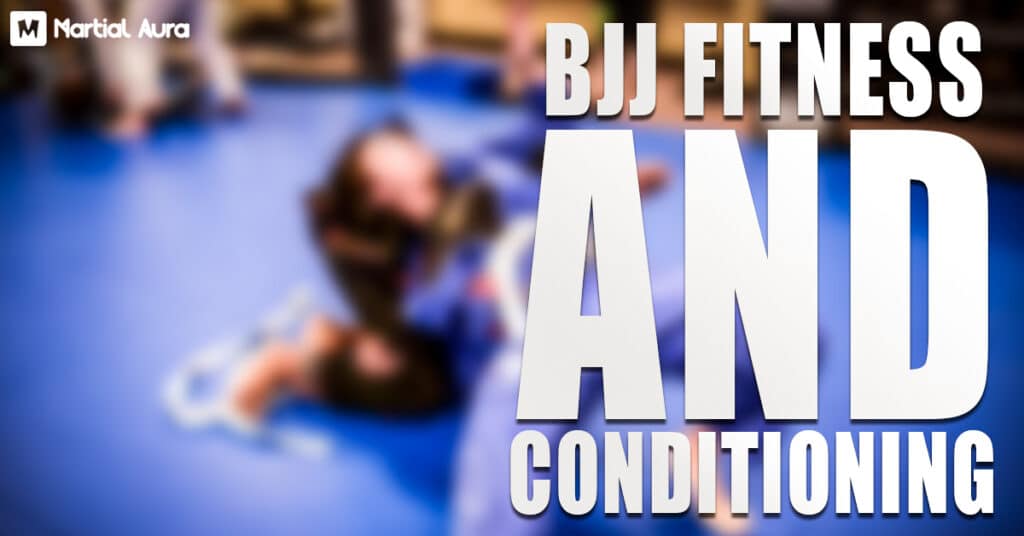Introduction
Brazilian Jiu-Jitsu (BJJ) is an exciting martial art that has gained immense popularity in the USA. It’s not just a sport but a way of life that enhances physical and mental fitness. Understanding BJJ fitness and conditioning is vital for practitioners who wish to improve their performance on the mat. This guide will delve into the various aspects of fitness and conditioning specific to BJJ, emphasizing their importance in achieving success in this dynamic discipline.
This article aims to provide you with in-depth knowledge and actionable advice on fitness for Brazilian Jiu-Jitsu, helping you optimize your training and conditioning. Whether a beginner or an advanced practitioner, this guide will help you enhance your Jiu-Jitsu workout and overall performance.
Understanding BJJ Fitness and Conditioning

What is BJJ Fitness?
BJJ fitness refers to the physical preparedness required to effectively engage in Brazilian Jiu-Jitsu. It encompasses several key areas:
- Cardiovascular Endurance: Essential for maintaining energy throughout a match.
- Strength: Critical for executing techniques and submissions effectively.
- Flexibility: Helps perform complex movements and reduce injury risk.
- Agility: Enables quick movements and reactions during sparring.
Being fit for BJJ means developing these components to improve your performance on the mat. A solid fitness foundation allows you to perform techniques more efficiently and recover faster between training sessions.
The Importance of Conditioning in BJJ
Conditioning plays a crucial role in Brazilian Jiu-Jitsu. Here’s why it matters:
- Enhanced Performance: Better conditioning leads to improved stamina, allowing you to train longer and with more intensity.
- Injury Prevention: A well-conditioned body is less susceptible to injuries, especially in high-impact sports like BJJ.
- Improved Recovery: Good conditioning aids in faster recovery, letting you train consistently.
Understanding these benefits is vital for anyone serious about their BJJ strength and conditioning. It’s not just about practicing techniques; it’s about preparing your body for the demands of the sport.
Key Components of BJJ Fitness

Cardiovascular Conditioning
Cardiovascular conditioning is critical in BJJ. Here are some effective methods to enhance your cardio:
- Interval Training: Short bursts of intense exercise followed by rest. This mimics the explosive nature of a BJJ match.
- Long-Distance Running: Building endurance with steady-state cardio improves your aerobic capacity.
Recommended Duration and Frequency:
- Aim for 3-4 cardio sessions per week.
- Each session should last between 20-40 minutes, depending on your current fitness level.
Strength Training for BJJ
Strength training is essential for developing the power necessary in BJJ. A few key exercises include:
- Deadlifts: Great for building overall strength and power.
- Squats: Essential for leg strength, which is vital for grappling.
- Kettlebell Swings: Excellent for building explosive hip power.
Incorporating these strength exercises for BJJ into your routine will enhance your overall performance on the mat.
Flexibility and Mobility
Flexibility is often overlooked in BJJ training. It plays a crucial role in executing techniques effectively and preventing injuries. Here are some Brazilian Jiu Jitsu stretches to include in your routine:
- Hip Openers: Help in executing guard techniques.
- Shoulder Stretches: Aid in preventing injuries during grappling.
Recommended Stretching Routine:
- Spend 10-15 minutes before and after each training session on BJJ stretches to maintain flexibility.
Agility and Reaction Time
Agility is a crucial component of success in BJJ. Improving your agility can help you react quickly and escape submissions. Here are some drills to enhance your agility:
- Cone Drills: Set up cones and sprint between them to improve footwork.
- Lateral Shuffles: Great for mimicking movements during sparring.
Incorporating agility training into your routine will give you a significant edge during training and competitions.
Creating a BJJ Fitness and Conditioning Program

Assessing Your Current Fitness Level
Before starting any fitness program, it’s essential to evaluate your current fitness level. Consider:
- Cardio Tests: Measure how long you can sustain high-intensity exercise.
- Strength Tests: Assess how much weight you can lift in basic exercises like squats and deadlifts.
Goal-Setting: Set realistic fitness goals based on your assessment. This will help you track your progress and stay motivated.
Designing Your BJJ Training Schedule
Integrating fitness and conditioning into your training schedule is crucial for success. Here’s how to design an effective routine:
- BJJ Classes: Attend 2-4 classes per week.
- Conditioning Sessions: Include 2-3 strength and conditioning workouts.
- Rest Days: Ensure you have at least one full rest day per week.
Sample Weekly Schedule:
| Day | Activity |
|---|---|
| Monday | BJJ Class + Conditioning |
| Tuesday | Strength Training |
| Wednesday | BJJ Class |
| Thursday | Rest |
| Friday | BJJ Class + Cardio |
| Saturday | Strength Training |
| Sunday | Active Recovery (Light Cardio) |
Sample BJJ Fitness Routine
Here’s a simple BJJ workout plan that combines various fitness components:
- Warm-Up (10-15 minutes): Dynamic stretches and light cardio.
- Strength Training (30-45 minutes): Focus on compound movements.
- BJJ Drills (30 minutes): Work on specific techniques.
- Conditioning (20-30 minutes): Finish with interval training or sprints.
- Cool Down (10 minutes): Static stretching.
This routine provides a balanced approach to enhance your BJJ conditioning while building strength and endurance.
Nutrition for BJJ Fitness and Recovery

Fueling Your Body for Optimal Performance
Proper nutrition is vital for BJJ fitness and conditioning. A well-balanced diet helps in recovery and performance. Focus on these macronutrient ratios:
- Carbohydrates (50-60%): Essential for energy, especially before training.
- Proteins (20-30%): Critical for muscle repair and recovery.
- Fats (20-30%): Support overall health and energy levels.
Sample Meals:
- Breakfast: Oatmeal with fruit and nuts.
- Lunch: Grilled chicken salad with quinoa.
- Dinner: Salmon with sweet potatoes and vegetables.
Hydration Strategies
Staying hydrated is crucial for maintaining performance and recovery. Follow these tips:
- Drink Water: Aim for at least 2-3 liters per day, adjusting for training intensity.
- Electrolytes: Consider electrolyte drinks during long training sessions to replenish lost minerals.
Supplements for BJJ Athletes
While whole foods should be your primary source of nutrition, some supplements can be beneficial:
- Protein Powders: Help meet protein needs for muscle recovery.
- BCAAs: May reduce muscle soreness and aid recovery.
Caution: Don’t rely solely on supplements. Focus on a balanced diet rich in nutrients.
Common Challenges and Solutions

Overcoming Plateaus in Fitness
Many practitioners experience fitness plateaus. Here’s how to overcome them:
- Change Your Routine: Alter your workouts to introduce new exercises.
- Increase Intensity: Push yourself with heavier weights or shorter rest periods.
- Set New Goals: Reassess your goals and aim for higher achievements.
Injury Prevention and Recovery
Injuries are common in BJJ, but proper conditioning can reduce the risk. Here’s how:
- Focus on Mobility: Include flexibility and mobility exercises in your routine.
- Listen to Your Body: Rest if you feel pain or discomfort to prevent aggravating injuries.
Recovery Tips:
- Active Recovery: Engage in light activities like walking or yoga on rest days.
- Ice and Elevation: Use ice packs and elevate injured areas to reduce swelling.
Conclusion
BJJ fitness and conditioning are vital for anyone involved in Brazilian Jiu-Jitsu. By focusing on various fitness components, creating a structured training program, and maintaining proper nutrition, you can significantly enhance your performance and overall experience on the mat.
As you incorporate these strategies into your routine, remember to listen to your body and adjust your training as needed. The journey to achieving your BJJ body transformation will require dedication and persistence, but the rewards are worth the effort.
Additional Resources
Here are some helpful resources for further reading on BJJ fitness and conditioning:
- Books: “The Jiu-Jitsu University” by Saulo Ribeiro
- Websites: BJJ Fanatics, Jiu-Jitsu Times
- Online Courses: Gracie University, BJJ Globetrotters
Feel free to share your experiences and tips in the comments below. Engaging with the BJJ community can provide valuable insights and motivation as you continue your journey in this incredible martial art.
Feel free to share your experiences and tips in the comments below. Engaging with the BJJ community can provide valuable insights and motivation as you continue your journey in this incredible martial art.”

James Wesley is a passionate martial arts enthusiast and the voice behind Martial Aura. With a deep love for UFC and combat sports, he shares expert insights and in-depth analysis on everything from fight strategies to athlete profiles. When he’s not writing, you’ll find him training or watching the latest fights, always learning from the best in the ring.






